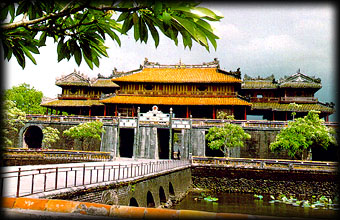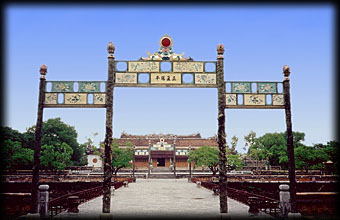| |
 Hue
Hue
Hue is located in Thua Thien prefecture and is
in the central part of Vietnam. Located 660 km from
Ha Noi and 1080 km from Saigon, Hue has always been
considered the fulcrum of Vietnam's two rice baskets,
the Red river delta and the Mekong delta. Hue became
the name of Vietnam's most well known ancient capital
because of the local mispronunciation of the word Hoá
in Thuâ.n Hoá.
Since the 16th century, Thuan Hoa, due to its strategic
location, has been a very prosperous area. The Nguyen
Lord chose this area to be their headquarters. Nguyen
Anh made it Vietnam's capital city in 1802 after he
defeated the Tay Son and ascended to the throne with
the name Gia Long. King Gia Long (1762-1819) was credited
for building and fortifying Hue from the very beginning.
Since then, successive king of the Nguyen Dynasty has
added to the foundation set by his predecessors. |
 Ngo Mon
Ngo Mon
Ngo Mon was constructed in 1833 during the reign
of Emperor Minh Mang. The gate leads to the Imperial
Palace and was the observation point for the Emperor
to review his troops and for ceremonial use.
Midday Gate is divided into two levels. At ground level,
the gate actually has five entrances. The one in the
center is used only by the king. On each side are two
entrances used by mandarins, soldiers and horses. On
the second level is Lau Ngu Phung - the Five-Phoenix
Pavilion. The king reviewed his troops and subjects
under the center hall of the pavilion. The roof of this
hall is covered with gold enameled tiles. The two halls
flanking the center hall were reserved for other members
of the court. |
 Dien Thai Hoa
Dien Thai Hoa
The Palace of Supreme Harmony houses the thrones
of the 13 emperors in the Nguyen Dynasty from Gia long
to Bao Dai. It was built in 1805. The palace and San
Dai Trieu (Esplanade of Great Salutation) were the site
for all major festivities such as Coronation Ceremony,
the Emperor's birthday, and where the king held court
during the first and fifteen day of the lunar month.
On these occasions, the king sat on the throne located
in the palace, and the mandarins lined the court according
to their rank and title from first to ninth grade, civil
mandarins on the left and military mandarins on the
right. |
|
|
|

